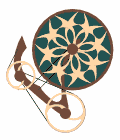
Some years ago I initiated a collaboration between the worlds of art and mathematics for Maths Year 2000 in the UK. I was pleasantly surprised at the enthusiasm of the art galleries in allowing this new dimension to be added to their displays. It was not about a superficial geometric analysis but about some deeper ideas that the artist was expressing and which, perhaps, needed some light shone upon them.
In my readings of that period, I recall a brief document: the Manifeste Dimensioniste, by Charles Sirato, Paris, 1936. Although penned at a time when some of the famous early-modern movements were already past their most fecund phase, the Dimensionist Manifesto gushes forth an exuberance that this is just the beginning! It takes its inspiration from “the new conception of space and time” as developed in “geometry, mathematics and physics.”
Sirato used the expression “N+1” as an artistic function to expand each artform by an extra dimension. Thus, paintings come out of their canvas and statues become kinetic; his ultimate vision is of a “Cosmic Art”, a “Vaporisation of Sculpture” (sounds pretty close to virtual reality environments). Indeed, I couldn’t help feeling that contemporary art after that point was just different ways of following the Dimensionist Manifesto; yet another installation syndrome!
So, if you’re an artist or art historian, did this Manifesto influence you at all? If you are reading it now for the first time, how forward-looking is it? Does it, even now, some 80 years later, open up any further new dimensions?
Please upvote, resteem and follow @rycharde… and upvote each other’s comments too!
